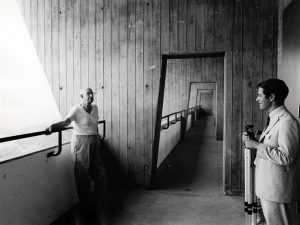
Purchase Tickets
The Legacy of Architect Evans Woollen
May 17, 2018

Today marks the two-year anniversary since we lost Indiana’s great Modernist architect, Evans Woollen. Woollen, a Yale University grad who studied under famed “Glass House” architect Philip Johnson, established his Indianapolis firm in 1955. Woollen’s earliest works consisted of mid-century modern residences, but he soon began exploring Brutalism with Clowes Memorial Hall, Barton Towers, and Minton-Capehart Federal Building. The cold, unornamented Brutalist style has become one of the most controversial styles throughout the world and remains highly regarded for its significance in architectural history. It is often said that mid-century architects had an “out with the old, in with the new” attitude regarding older buildings, but this was simply not the case for Woollen as his firm planned the historic rehabilitation of numerous Indianapolis apartment buildings, churches, commercial buildings and theatres. His career concluded with several contemporary churches, museums and libraries, where he playfully experimented with massing and referenced geometry in terms of the form, facades, and fenestration.

Thurston Residence, 1958
The Woollen, Molzan & Partners, Inc. Architectural Records collection contains building specifications and planning materials for more than 160 projects, more than 3,000 architectural drawings, more than 10,000 photographs, negatives and slides documenting multiple phases of construction projects from models to completion, oral histories and lectures, and articles and press clippings covering the firm until their 2011 dissolution. The collection also includes an additional 25 unbuilt projects. Woollen’s projects are surprisingly almost all extant, many of which remain unaltered to this day.

Woollen working with Barton Towers resident, undated
Throughout Indianapolis and in many Indiana cities, you may discover a Woollen building. Next time I do, I’ll be thinking about the architectural legacy he left for us along with his words: “Meaning in architecture is elusive; meaning is partial; it’s found in the nuances. It’s layered sometimes, nebulous other times. There are some architects today who wish to reflect the fragmentation, chaos, and entropy that they find in the world around them. We must be non-judgmental, pluralistic, and inclusive. But conversely, I am interested in buoying spirits, meanings that are androgynous; harmonic order that is comforting.” [From the video, Building for Meaning: The Architecture of Evans Woollen]

Barton Towers, 1968
If you want to learn more about Woollen and his buildings, the collection guide is available here. Additionally, we are celebrating two of Woollen’s masterpieces, Barton Towers and the Minton-Capehart Federal Building, on upcoming summer architectural tours.









